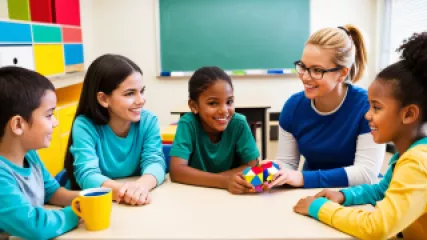Developing an Effective Special Education Curriculum
Developing an Effective Special Education Curriculum
In the world of education, crafting a curriculum that caters to the unique needs of students with special needs is a critical and multifaceted endeavor. As an educator or administrator, you are tasked with the responsibility of creating a learning environment that fosters growth, empowers individuals, and ensures equal access to educational opportunities. This step-by-step guide will delve into the essential elements of developing an effective special education curriculum, equipping you with the knowledge and strategies to make a lasting impact on the lives of your students.
Understand the Diverse Needs of Special Education Students
The first step in developing an effective special education curriculum is to gain a comprehensive understanding of the diverse needs of your students. Special education encompasses a wide range of learning differences, including but not limited to intellectual disabilities, physical disabilities, emotional and behavioral disorders, and specific learning disabilities. Each student is unique, with their own set of strengths, challenges, and learning preferences.
To effectively cater to these diverse needs, it is essential to conduct thorough assessments, gather detailed student information, and collaborate with multidisciplinary teams, including special education teachers, therapists, and parents or guardians. This collaborative approach will help you identify the specific areas of support required for each student, enabling you to tailor the curriculum accordingly.
Establish Clear Learning Objectives and Measurable Goals
Once you have a deep understanding of your students' needs, the next step is to establish clear learning objectives and measurable goals. These objectives and goals should be aligned with the individual education plans (IEPs) or personalized learning plans (PLPs) developed for each student.
When setting these objectives and goals, it is crucial to consider the following factors:
- Individualization: Ensure that the objectives and goals are tailored to the unique strengths, needs, and learning styles of each student.
- Functionality: Focus on developing skills and knowledge that are applicable to the student's daily life and future independence.
- Measurability: Establish clear, quantifiable criteria for assessing the student's progress and achievement.
- Collaboration: Involve the student, parents or guardians, and the multidisciplinary team in the goal-setting process to ensure alignment and shared understanding.
By establishing these clear and measurable goals, you can effectively track the progress of your students and make informed decisions about curriculum modifications and instructional strategies.
Adopt a Multisensory and Multimodal Approach
One of the key principles of effective special education curriculum development is the adoption of a multisensory and multimodal approach. Many students with special needs respond better to learning experiences that engage multiple senses, such as sight, sound, touch, and movement.
Incorporating a variety of instructional materials, teaching methods, and learning activities can help to create a more inclusive and engaging learning environment. Some examples of a multisensory and multimodal approach include:
- Visual aids: Using visual tools, such as pictures, diagrams, and graphic organizers, to support comprehension and retention of information.
- Auditory inputs: Incorporating audio recordings, music, and verbal explanations to cater to students who learn best through listening.
- Tactile and kinesthetic activities: Providing hands-on experiences, manipulatives, and movement-based learning opportunities to engage students who are tactile or kinesthetic learners.
- Technology-enhanced learning: Integrating assistive technologies, such as text-to-speech software, digital learning platforms, and adaptive technologies, to personalize the learning experience.
By embracing a multisensory and multimodal approach, you can create a learning environment that caters to the diverse learning preferences of your students, enhancing their engagement, understanding, and overall academic success.
Incorporate Differentiated Instruction
Differentiated instruction is a fundamental aspect of an effective special education curriculum. This approach involves tailoring the content, process, and product of learning to meet the specific needs of each student. By differentiating instruction, you can ensure that all students, regardless of their abilities, have equal opportunities to access and engage with the curriculum.
Some key strategies for implementing differentiated instruction in your special education curriculum include:
- Content Differentiation: Adapting the complexity, depth, and breadth of the subject matter to align with each student's readiness level and learning preferences.
- Process Differentiation: Providing a variety of learning activities, instructional methods, and scaffolding techniques to support diverse learning styles and needs.
- Product Differentiation: Allowing students to demonstrate their understanding and knowledge through a range of assessment options, such as written assignments, oral presentations, or project-based learning.
- Learning Environment Differentiation: Creating a flexible and inclusive classroom environment that accommodates individual needs, such as quiet zones, sensory-friendly areas, or flexible seating arrangements.
By embracing differentiated instruction, you can ensure that your special education curriculum is responsive, inclusive, and accessible to all students, empowering them to reach their full potential.
Emphasize Skill Development and Functional Life Skills
In the context of special education, the curriculum should not only focus on academic content but also prioritize the development of critical life skills. These functional life skills are essential for students to achieve greater independence, self-sufficiency, and successful integration into their communities.
Some key areas of functional life skill development that should be integrated into your special education curriculum include:
- Self-care and independence: Activities related to personal hygiene, dressing, meal preparation, and money management.
- Social and communication skills: Instruction on interpersonal communication, conflict resolution, and social interaction.
- Daily living skills: Training in household management, transportation, and community navigation.
- Vocational and career exploration: Exposure to the world of work, job-related skills, and career planning.
- Leisure and recreation: Opportunities for engaging in recreational activities, hobbies, and community involvement.
By emphasizing the development of these functional life skills, your special education curriculum can better prepare students for successful transitions to independent living, employment, and active participation in their communities.
Foster Collaboration and Inclusive Practices
Developing an effective special education curriculum requires a collaborative approach that involves various stakeholders, including teachers, parents or guardians, related service providers, and the students themselves. This collaborative effort ensures that the curriculum is aligned with the individual needs of each student and that all parties are invested in the student's academic and personal growth.
Some key strategies for fostering collaboration and inclusive practices in your special education curriculum include:
- Ongoing Communication: Establish regular channels of communication, such as meetings, progress reports, and feedback sessions, to ensure that all stakeholders are informed and involved in the decision-making process.
- Inclusive Team Meetings: Facilitate team meetings that bring together the multidisciplinary team, including teachers, therapists, and parents or guardians, to discuss student progress, review IEPs or PLPs, and collaborate on curriculum modifications and instructional strategies.
- Student-Centered Approach: Actively involve the students in the goal-setting process, provide opportunities for self-advocacy, and empower them to take an active role in their own learning and decision-making.
- Community Partnerships: Establish partnerships with community organizations, local businesses, and resource centers to expand the learning experiences and post-secondary pathways available to your students.
By fostering collaboration and inclusive practices, you can create a special education curriculum that is responsive, holistic, and designed to support the unique needs and aspirations of each student.
Continuously Evaluate and Refine the Curriculum
Developing an effective special education curriculum is an ongoing process that requires continuous evaluation and refinement. As the needs of your students evolve and new educational approaches emerge, it is crucial to regularly assess the effectiveness of your curriculum and make necessary adjustments.
Some key strategies for continuous evaluation and refinement include:
- Data-Driven Decision Making: Regularly collect and analyze student performance data, including academic progress, skill development, and behavioral indicators, to identify areas for improvement and inform curriculum modifications.
- Seeking Feedback: Actively solicit feedback from students, parents or guardians, and the multidisciplinary team to understand the strengths and weaknesses of the curriculum and identify opportunities for enhancement.
- Staying Current with Research and Best Practices: Continuously research and stay updated on the latest trends, evidence-based practices, and innovative approaches in special education curriculum development to ensure that your program remains cutting-edge and effective.
- Implementing Pilot Programs: Consider implementing pilot programs or small-scale curriculum changes to test the viability and effectiveness of new strategies before implementing them on a larger scale.
By embracing a culture of continuous evaluation and refinement, you can ensure that your special education curriculum remains responsive, dynamic, and aligned with the evolving needs of your students.
Conclusion
Developing an effective special education curriculum is a multifaceted and dynamic process that requires a deep understanding of your students' diverse needs, a commitment to collaborative and inclusive practices, and a willingness to continuously evaluate and refine your approach. By incorporating the strategies and principles outlined in this guide, you can create a curriculum that empowers your students, fosters their growth and independence, and prepares them for successful transitions into adulthood and their communities.
Remember, the key to an effective special education curriculum lies in its ability to be responsive, individualized, and centered on the unique strengths and needs of each student. By embracing this holistic and student-centered approach, you can make a lasting impact on the lives of the individuals you serve, equipping them with the knowledge, skills, and confidence to thrive in their educational journeys and beyond.
In summary, the essential elements of developing an effective special education curriculum include:
- Understanding the diverse needs of special education students
- Establishing clear learning objectives and measurable goals
- Adopting a multisensory and multimodal approach
- Incorporating differentiated instruction
- Emphasizing skill development and functional life skills
- Fostering collaboration and inclusive practices
- Continuously evaluating and refining the curriculum
By implementing these strategies and principles, you can create a special education curriculum that truly empowers your students, supports their growth, and prepares them for successful and fulfilling futures.






